Documents: Go to download!
- User Manual - (English)
- User Manual - (Spanish)
- Getting to Know Your TV
- Completing the First-Time Setup
- Using the On-Screen Menu
- Troubleshooting
Table of contents
User Manual Television
Getting to Know Your TV
FRONT PANEL
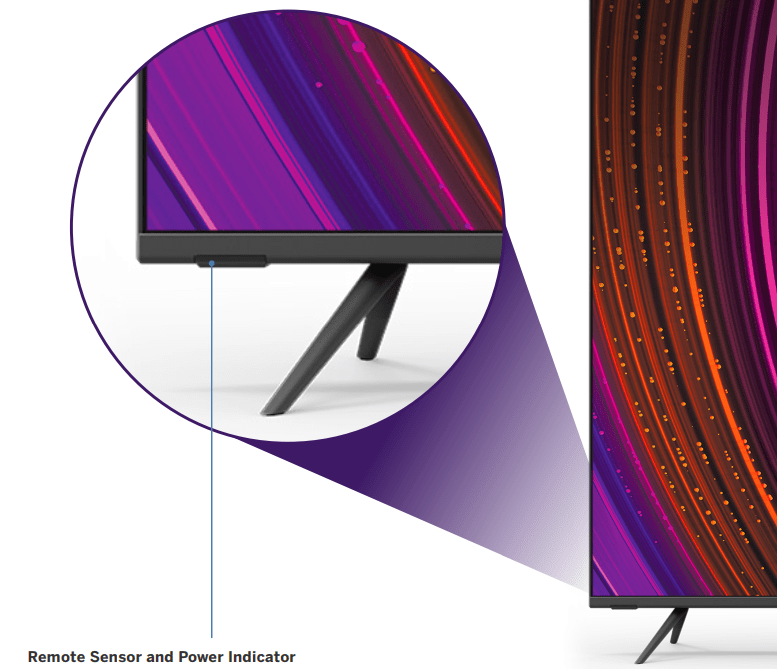
Remote Sensor and Power Indicator: When using the remote, aim it directly at this sensor. The power indicator flashes on when the TV turns on, then goes out after several seconds. To keep the power indicator on, see Turning the Power Indicator On or Off section.
REAR PANEL
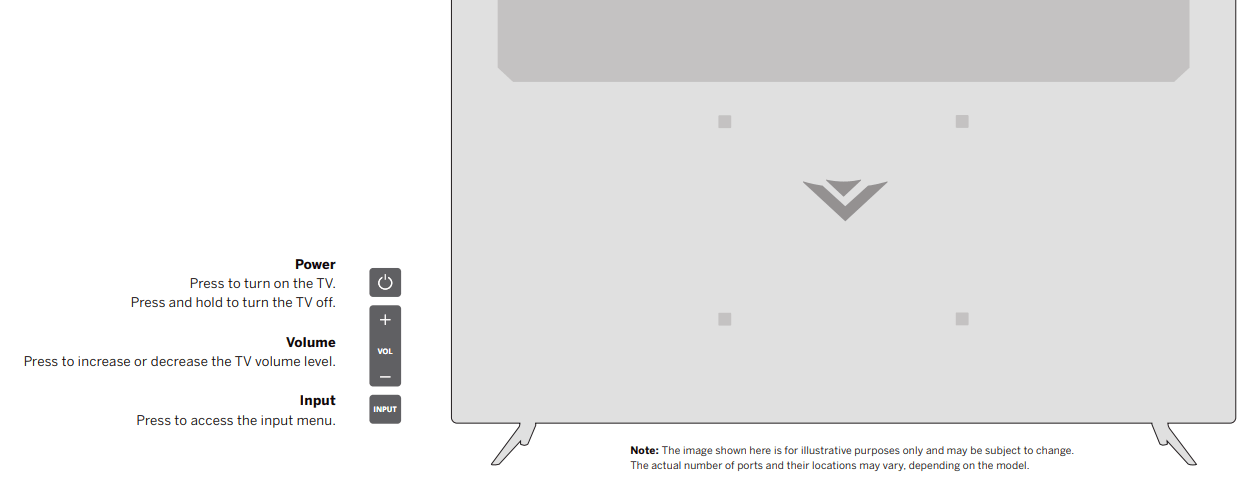


Connecting a device — AUDIO & VIDEO CABLE TYPES
Your TV can be used to display output from most devices.
- Verify that your device has a video port that matches an available port on the TV (HDMI, Composite, etc.).
- Connect the appropriate cable (not included) to the TV and the device.
- Turn the TV and your device on.
- Set the TV’s input to match the connection you used (HDMI-1, HDMI-2, etc.).

Connecting a device — AUDIO CABLE TYPES
Your TV can be output sound to an audio device, such as a receiver or sound bar.
- Verify that your device has an audio port that matches an available port on the TV (optical, RCA, etc).
- Connect the appropriate cable (not included) to the TV and the device.
- Turn the TV and your device on.
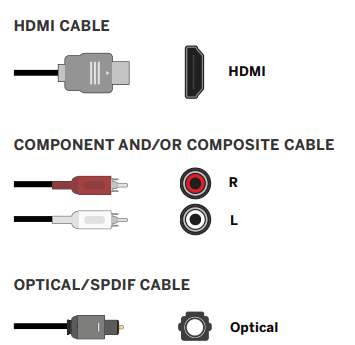
WALL-MOUNTING THE TV
First you will need a wall mount. Consult the provided table below to find the appropriate mount for your TV. Be sure the mount you choose is capable of supporting the weight of the TV. To install your TV on a wall:
- Disconnect any cables connected to your TV.
- Place the TV face-down on a clean, flat, stable surface. Be sure the surface is clear of debris that can scratch or damage the TV.
- If attached, remove the stands by loosening and removing the screws.
- Attach your TV and wall mount to the wall by carefully following the instructions that came with your mount. Use only with a UL-listed wall mount bracket rated for the weight/load of your TV.
TIP: Installing a TV on a wall requires lifting. To prevent injury or damage to the TV, ask someone to help you.
WARNING: Do not use the screws that are included inside the wall mount holes to mount TV.


USING THE REMOTE
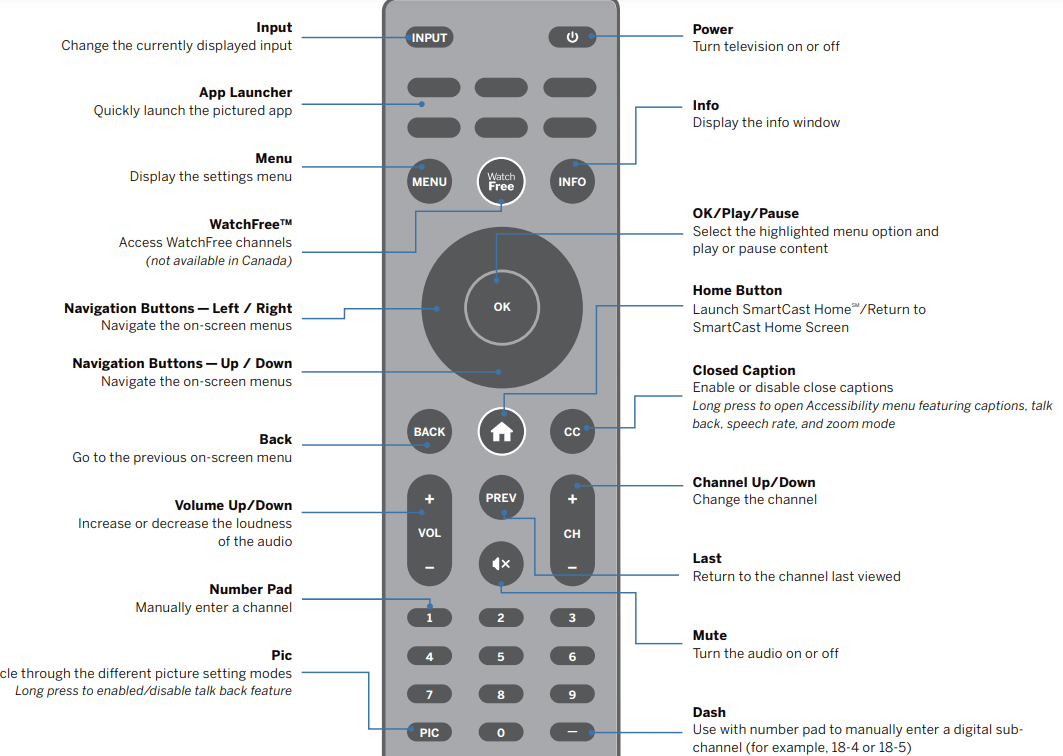
Replacing the Batteries
- Push the bottom of the battery compartment and lift battery cover to open.
- Insert two batteries into the remote control. Make sure that the (+) and (-) symbols on the batteries match the (+) and (-) symbols inside the battery compartment.
- Replace the battery cover and click to close.

WARNING: Keep the remote control batteries away from children. It may cause choking and/or lead to a fire or chemical burn if mishandled. Do not dispose of batteries in fire. Replace only with batteries of the correct type.
TIP: When needed, VIZIO recommends replacing the batteries that came with this remote with two, new Duracell ‘AAA’ alkaline batteries.
Completing the First-Time Setup
Before you begin the first-time setup:
- Your TV should be installed and the power cord should be connected to an electrical outlet.
- If you have a wireless network, have the network password ready.
- If you are connecting to your network with an Ethernet cable, connect it to the Ethernet port on the TV.
The first time you turn on the TV, the on-screen instructions will guide you through each of the steps necessary to get your TV ready for use:
1. Choose your language.Pressing the CC button will enable TTS (text-to-speech) functionality.
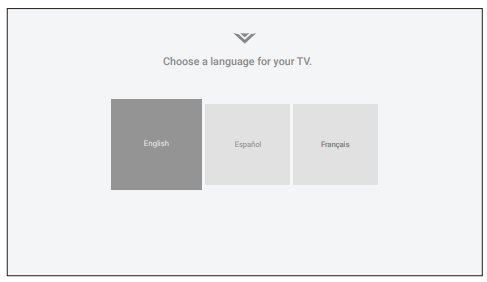
2. Choose home use.

3. Choose your country.
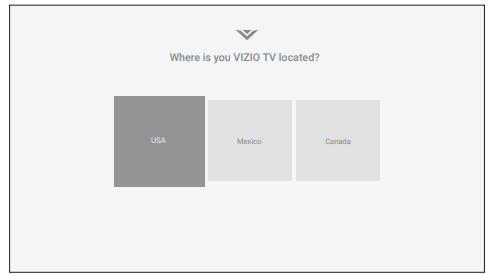
4. Choose your Wi-Fi network and enter the password.
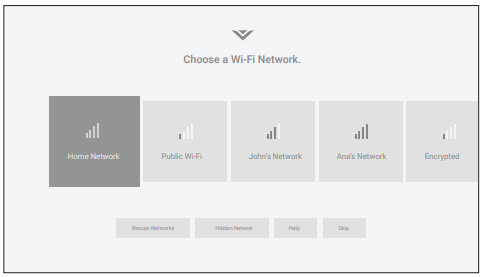
5. Name your TV.
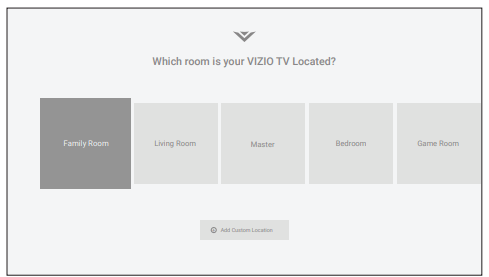
6. Scan for channels.
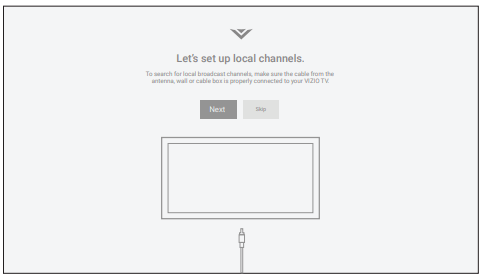
7. Accept the Terms & Conditions.
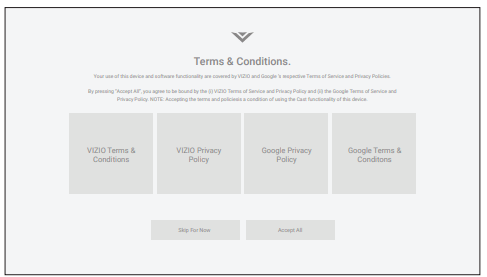
8. View and accept VIZIO Viewing Data Policy.

Using the On-Screen Menu
Your TV features an easy-to-use on-screen menu
To open the on-screen menu, press the MENU button on the remote.
From this menu, you can:
- Adjust the picture settings
- Adjust the audio settings
- Adjust the network settings
- Adjust the TV channel settings
- Adjust accessibility settings
- Adjust TV system settings
- Access admin and privacy settings
- View the user manual

NAVIGATING THE ON-SCREEN MENU
To open the on-screen menu:
- Press the MENU button on the remote.
- Use the Navigation buttons to highlight a menu option, and press the OK button to select that option.
TIP: While navigating the on-screen menu, you can press the BACK button at any time to return to the previous menu screen.
CHANGING THE INPUT SOURCE
External devices, such as DVD players, Blu-ray players, and video game consoles, can be connected to your TV.
To use one of these devices with your TV, you must first change the input source using the input menu. To change the input sources:
- Press the INPUT button on the remote. The input menu is displayed.
- Use the Navigation buttons or the INPUT button on the remote to highlight the input you wish to view. The corresponding inputs are named on the back of your TV.
- Press OK or release the INPUT button. The selected input is displayed.

TIP: You can change the input names that appear on the Input menu to make your devices easy to recognize. See Renaming Devices on the Input Menu section.
ADJUSTING THE PICTURE SETTINGS
Your TV can be adjusted to suit your preferences and viewing conditions.
To adjust the picture mode settings: Menu > Picture > Picture Mode
1. Use the Navigation buttons on the remote to highlight Picture Mode, then use the Left/Right Navigation buttons to change the picture mode:
- Vivid — Sets the picture settings to values that produce a brighter, more vivid picture.
- Bright — Sets the picture settings to values ideal for watching TV in a brightly-lit room.
- Calibrated — Sets the picture settings to the default settings.
- Calibrated Dark — Sets the picture settings to values ideal for watching TV in a dark room.
- Game — Reduces throughput delays and optimizes the picture settings for displaying game console output. Also the preferred picture mode for computer mode.
- Sports — Sets the picture settings to values ideal for watching sport events with motion control setting.
2. To manually change each of the picture settings, use the Up/Down Navigation buttons on the remote to highlight that picture setting, then use the Left/Right Navigation buttons to adjust the setting:

- Ambient Light Sensor — Detects your room's light level and automatically adjusts the background. Select Low for the darkest picture or High for the brightest picture. Select Off for manual backlight control.
- Backlight (SDR content) or Tone Mapping (HDR content) — Adjusts the LED brightness to affect the overall brilliance of the picture.
- Brightness — Adjusts the black level of the picture. When this setting is too low, the picture may be too dark to distinguish details. When this setting is too high, the picture may appear faded or washed out.
- Contrast — Adjusts the white level of the picture. When this setting is too low, the picture may appear dark. When this setting is too high, the picture may appear faded or washed out. If the setting is too high or too low, detail may be difficult to distinguish in dark or bright areas of the picture.
- Color — Adjusts the intensity of the picture colors.
- Tint — Adjusts the hue of the picture. This setting is useful in adjusting the flesh tones in the picture. If flesh appears too orange, reduce the level of color before adjusting tint.
- Sharpness — Adjusts the edge sharpness of picture elements. It can be used to sharpen non-HD (high definition) content; however, it will not produce detail that does not otherwise exist.
Adjusting the Color Temperature
- Adjusting the color temperature changes the white balance of the picture.
- To adjust the color temperature: Menu > Picture > Color Temperature
- Use the Navigation buttons on the remote to highlight a color temperature preset and then press OK.
- Warm — Produces an orange-hued picture.
- Cool — Produces a blue-hued picture.
- Normal — Optimized for television viewing

ADJUSTING THE AUDIO SETTINGS
To adjust the audio settings: Menu > Audio
Use the Navigation buttons to highlight the setting you wish to adjust, then press Left/Right Navigation buttons to change the setting:

- TV Speakers — Built-in speakers automaticcaly turn off if a sound bar is discovered. Turn the built-in speakers On or Off.
- Surround Sound — When set to On, enables surround sound suitable for sports and TV shows. Virtual:X™ adds virtualized height best for movies.
- Volume Leveling — When set On, DTS TruVolume™ audio solution levels the speaker volume.
- Balance — Balance the audio loudness between the left and right speakers.
- Lip Sync — Synchronize the display image with the audio track.
- Digital Audio Out — Select the digital audio output format for both the optical and HDMI ARC audio devices. - To hear talk back when Talk Back function is enabled, digital audio out must be set to PCM.
- Analog Audio Out — Select Variable if you are controlling the volume with the remote. Select Fixed if an external audio device (sound bar or AV receiver) will control the volume.
- Dialogue Enhancer — If enabled and the signal source includes Dolby 5.1 AC-4 audio then clarity of dialogue is enhanced.
- eARC — Toggle between ARC (Off) and eARC (On) for audio output using HDMI 1. If On, audio is sent using eARC and is uncompressed. If Off, audio is sent using ARC and some audio formats may play in standard Dolby Audio, DTS Digital Surround, or PCM.
- Equalizer — Only available when Surround Sound is set to OFF. Boosts or attenuates loudness at different frequencies.
ADJUSTING THE NETWORK SETTINGS
Your TV is Internet-ready, featuring both an Ethernet port and built-in high-speed wireless internet.
Connecting to a Wireless Network

- To connect to a wireless network whose network name (SSID) is being broadcast: Menu > Network > Choose your network > Enter in the password > Connect
- To forget a saved network: Highlight a saved wireless access point > OK > Forget
- If you do not see your wireless network displayed, click on: More Access Points > Highlight your wireless network > Enter in the password > Connect
Changing the Manual Setup Settings
Advanced users can fine-tune the network settings using the Manual Setup feature. The security settings on your router may require you to enter the TV's MAC address.
To change advanced network settings: Menu > Network > Manual Setup > DHCP > Off

- Use the Navigation and OK buttons to adjust each setting:
- IP Address — The IP address assigned to the TV.
- Subnet Mask — The subnet Exit 2D.
- Default Gateway — Your network’s default gateway address.
- Pref . DNS Server — Your preferred domain name server address.
- Alt . DNS Server — Your alternate domain name server address.
- Use the Navigation buttons on the remote to highlight Save and press OK.
To find the TV’s MAC address: Menu > Network > Manual Setup
You can find your TV's MAC address at the bottom of the list. The MAC addresses for the connections in use are displayed:
- RJ45 MAC — The Ethernet or RJ45 MAC address may be needed to set up your network when you have connected the TV to your network when you have connected the TV to your network with an Ethernet (Cat 5) cable.
- Wireless MAC — The Wireless (Wi-Fi) MAC address may be needed to connect your TV to your network with Wi-Fi.
Connecting to a Hidden Network
To connect to a wireless network whose network name (SSID) is not being broadcast: Menu > Network > Hidden Network > Enter the Access Point Name > Connect > Enter in the password
Testing Your Network Connection
To test your network connection: Menu > Network > Test Connection

SETTING UP TV CHANNELS
You can use the TV’s Channels menu to:
- Find channels
- Find new channels
- Select channels to skip
- Select analog audio mode
- Select the language for digital audio
- Set parental controls

Scanning for TV Channels
The TV may need to scan for channels before it can display programs and their associated information. A channel scan is required for free over-the-air channels (using an antenna) and cable channels from an out-of-the-wall connection (without a cable box). Moving the TV to an area with different channels requires the TV to scan for channels again.
To perform an Auto Channel Scan: Menu > TV Channels > Find Channels Wait until the channel scan is 100% complete.
Highlight Done and press OK.
- If the channel scan is canceled, the channels that were already discovered are retained.

To perform a New Channel Scan: Menu > TV Channels > Find New Channels
A New Channel Scan saves the current channel map and scans for additional channels.
Skipping Channels
After a channel scan is completed, you may find that some channels are too weak to watch comfortably. There may also be some channels you do not want to view. You can remove these channels from the TV’s memory with the Skip Channel feature.
To remove a channel:

- From the TV CHANNELS menu, highlight Skip Channel, and press OK. The SKIP CHANNEL menu is displayed.
- For each channel you wish to remove, use the Up/Down Navigation buttons on the remote to highlight the channel and press OK. A
 appears to the right of each channel you select.
appears to the right of each channel you select.
ACCESSIBILITY SETTINGS
VIZIO is committed to providing intuitive, user-friendly products. Your new VIZIO TV offers several accessibility features that can help you with easy navigation.
To access the Accessibility menu: Menu > Accessibility

- Captions — Activate and customize analog and digital closed captions.
- Video Description — If included by the broadcaster, provides a narrated description of the action for the content.
- Talk Back* — Enables your TV to speak all settings changes and adjustments using the remote in English.
- Speech Rate — Adjusts the rate in which Text-to-Speech is spoken. Select Slow, Normal (default), or Fast.
- Zoom Mode — Enlarges a section of the screen by approximately 200%.
To access the Video Description menu: Menu > Accessibility > Video Description > Off/On
Setting Up Closed Captioning
Your TV can display closed captions for programs that include them. Closed captions display a transcription of a program’s dialogue.
To activate or deactivate Close Captions for current content: Menu > Accessibility > Captions > Closed Captions > Off/On — or —
Push the  button on the remote .
button on the remote .

- Use the Navigation buttons on the remote to highlight either Analog or Digital Closed Captions.
- Use the Left/Right Navigation buttons on the remote to select the caption channel you wish to display
Changing the Appearance of Digital Closed Captions
- Digital closed captions can be displayed according to your preference. See the diagram on the next page for an explanation of the parts of the closed caption area.
- To change the appearance of digital closed captions: Menu > Accessibility > Captions > Digital Style
- Use the Left/Right Navigation buttons on the remote to select Custom. The Digital Style menu appears as shown.
- Use the Up/Down Navigation buttons on the remote to highlight the setting you wish to change, then use the Left/Right Navigation buttons to change the settings (choose "As Broadcast" to keep default setting):

- Text Style — Change the font used for the closed captioning text.
- Text Size — Make the text larger or smaller.
- Text Color — Change the color of the text.
- Text Opacity — Change the transparency of the text.
- Text Edges — Change the effects at the edges of the text, such as raising the edges or adding drop shadows.
- Text Edges Color — Change the color of the text edge effects.
- Background Color — Change the color of the background directly behind the text.
- Background Opacity — Change the transparency of the background directly behind the text.
- Window Color — Change the color of the closed captioning box.
- Window Opacity — Change the opacity of the closed captioning box.
Typical choices include:
- Opaque background, transparent window — Only a strip of background appears behind the text, expanding as the text appears. This is the typical "As Broadcast" mode.
- Opaque background and window in the same color — When text appears, the entire line fills with color at once.
In the example, the closed caption text is green, the background is black, and the window is red.

CHANGING THE SYSTEM SETTINGS
Using the System menu, you can:
- Change the on-screen menu language
- Set the time zone and local settings
- Name the TV
- Name an input
- Hide inputs not in use
- Adjust the power mode settings
- Set the USB power mode
- Turn the power indicator on or off
- Set up timers
- Set a system PIN code
- Adjust CEC settings
- Manage paired devices
- Manage a voice remote control
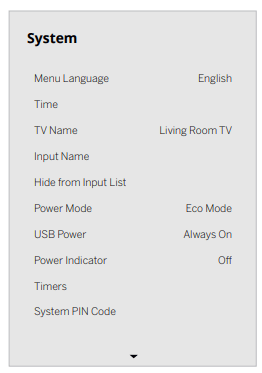
Changing the On-Screen Menu Language
Your TV can display the on-screen menu in different languages.
To change the on-screen menu language: Menu > System > Menu Language
Highlight your preferred language (English, Español, or Français) and press OK.

Setting the Time
To ensure the correct time is displayed when you press the INFO button, set the TV’s time zone:
Menu > System > Time > Time Zone
To turn Daylight Saving Time on or off:
- Highlight Daylight Saving Time and press OK. The Daylight Saving Time menu is displayed.
- Choose On if it is currently Daylight Savings Time, Off if it is Standard Time, or Auto to have the system automatically detect Daylight Savings Settings.
To change Time Format:
- Highlight Time Format and use the Left/Right Navigation buttons to change between a 12-hour format or 24-hour format.
Changing the TV Name
Naming your TV helps differentiate it from other cast devices you may have in your home.
To edit your TV name:
Menu > System > TV Name > Enter a Name
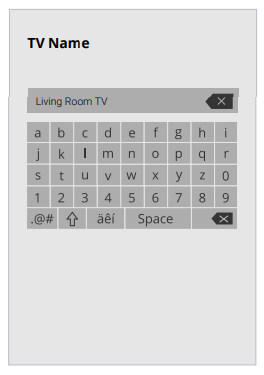
Renaming Devices on the Input Menu
You can rename the inputs to make them easier to recognize on the Input menu. For example, if you have a DVD player connected to the HDMI-1 input, you can rename that input to display “DVD Player.” See Changing the Input Source section.
To change the name of an input: Menu > System > Input Name
To enter a custom name:
- Highlight the Name Input row and press OK.
- Enter your custom label using the on-screen keyboard and press OK.
TIP: The current input you are on will be the input name you are changing. You cannot change every input (i.e. WatchFree or SmartCast inputs).
To Hide an Input from the List: Menu > System > Hide from Input List
- Highlight the input name you would like to hide. Hidden inputs will not be displayed in the input list.
- Use the Left/Right Navigation buttons to toggle from visible and hidden.
Adjusting the Power Mode
Your TV is set to Eco Mode by default. When the TV is powered off, the Eco Mode setting uses less than 0.5W of power. Quick Start Mode enables your display to power on faster and also to turn on when powered from another device (such as when you are casting onto the TV)
WARNING: Please note that by changing this setting the energy consumptions required to operate this device will change.
To switch between Eco Mode and Quick Start Mode: Menu > System > Power Mode
Highlight either Eco Mode or Quick Start Mode and press OK.
Using the USB Power Feature
The USB port can be used to charge devices. The two options for this feature are:
- Always On — Power is always available.
- Off When TV Off — Power is only available with the TV is on.
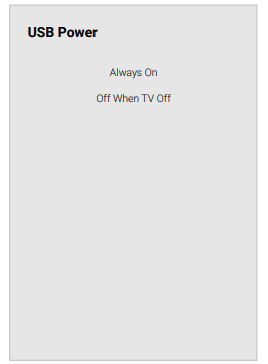
Turning the Power Indicator On or Off
The power indicator on the front of your TV normally does not glow when the TV is on. You can change this setting if you prefer the light to be on.
To turn the Power Indicator Light On or Off: Menu > System > Power Indicator > Off/On
Setting Timers
When activated, the TV’s timer will turn the TV off after a set period of time.
To setup a sleep timer: Menu > System > Timers > Sleep Timer
Use the Left/Right Navigation buttons on the remote to highlight the period of time after which you want the TV to go to sleep: 30, 60, 90, 120, or 180 minutes. If you don’t want the sleep timer to activate, change the setting to Off.
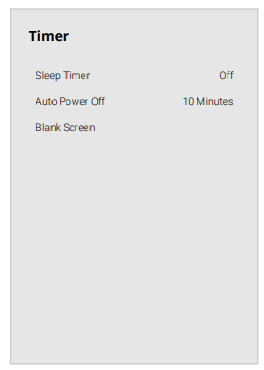
Setting the Auto Power Off Feature
To help save energy, your TV is set by default to turn off after 10 minutes without a video or audio signal. This feature can be deactivated.
To set the Auto Power Off feature: Menu > System > Timers > Auto Power Off > Off
Using the Blank Screen Feature
To help save LED life, your TV screen can turn on or off while audio is streaming.
To use the Blank Screen feature: Menu > System > Timers > Blank Screen
To exit Blank Screen, press any key (except the volume and mute keys).
Setting a System PIN Code
You can set a system pin to lock content and picture modes, as well as prevent accidental system resets. The first time you select System PIN code, you will need to create a PIN.
To create a PIN: Menu > System > System PIN Code > Enter Your PIN > Save
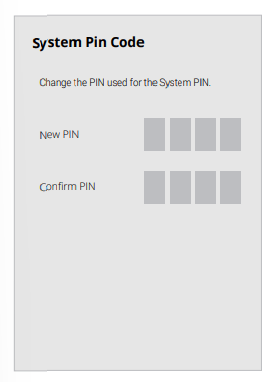
WARNING: You will need to enter your current PIN code the next time you access this menu or if you'd like to change your PIN.
Adjusting the CEC Settings
The CEC function on your TV enables you to control devices connected to an HDMI input with the VIZIO TV remote, without any programming
Menu > System > CEC
Select a setting and then press OK.
- CEC — To use CEC, you must select Enable.
- Device Discovery — To determine if your device is connected and supports CEC, select Device Discovery and then press OK. CEC Audio Setup Connect your audio device to the HDMI-1 (HDMI ARC) input on the TV. On your audio device, select the HDMI ARC input.
Using CEC, your VIZIO TV remote can control such features including (depending on specific device):
- Power On/Off
- Volume and mute
- Play and pause
Managing Mobile Devices
Your TV can be paired with a mobile device so you can easily control your TV across multiple devices.
To see a list of paired devices or unpair a device: Menu > System > Mobile Devices
Highlight a device name to delete it and press OK.
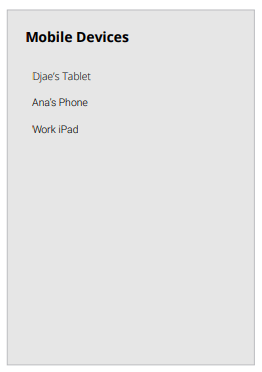
Troubleshooting
Help Topics
The remote is not responding .
- Make sure the batteries are properly inserted matching the - and + symbols.
- Replace the batteries with fresh ones.
2. The TV displays “No Signal .”
- Press INPUT button on the remote control to select a different input source.
- If you are using cable TV or antenna connected directly to the TV, scan for channels. See Scanning for TV Channels section.
3. There is no power .
- Ensure the TV is plugged into a working electrical outlet.
- Ensure the power cable is securely attached to the TV.
- Press the Power/Standby button on the remote or on the back of the TV to turn the TV on.
4. The power is on, but there is no image on the screen .
- Ensure all cables are securely attached to the TV.
- Ensure all devices are connected correctly. Devices differ; see your device’s user manual for details.
- Adjust Brightness, Contrast, or Backlight. See Adjusting the Picture Settings on page 8.
- Press the INPUT button on the remote to select a different input source.
5. The sound is flat or dialog is not audible .
- Turn off Volume Leveling. See Adjusting the Audio Settings section.
6. Where do I find information on the accessibility features of this product and other VIZIO products?
- Please visit vizio.com/accessibility,
- Email us at: [email protected], or Give us a call at 1-877-698-4746.
7. How do I stream apps like Netflix to my VIZIO SmartCast® TV?
- Popular apps are located on the SmartCast Home™ screen, so you can simply navigate to the app row on your SmartCast TV to start streaming.
- You can also use Apple AirPlay 2 or Chromecast built-in™ to stream content from your device directly to your SmartCast TV. For more information, please visit: − VIZIO.com/Apple − VIZIO.com/Google
8. The colors on the TV don’t look right .
- Adjust the Color and Tint settings in the Picture menu. See Adjusting the Picture Settings section.
- Select a pre-set picture mode. VIZIO recommends selecting Calibrated.
- Check all cables to ensure they are securely attached.
9. The image quality is not good .
- For the best image quality, view high-definition programs using digital sources. Connect your devices with HDMI cables.
- If you are using an antenna, the signal strength of the channel may be low. Ensure your antenna is connected securely to the TV and move the antenna around the room or close to a window for the best signal.
10. The picture is distorted .
- Move the TV away from electrical appliances, cars, and fluorescent lights.
- Ensure all cables are securely attached.
11. The TV image does not cover the entire screen .
- If you are using TV, AV, or Component with 480i input, go to Menu > Picture > Picture Aspect.
12. The TV has pixels (dots) that are always dark .
- Your HD TV is precision-manufactured using an extremely high level of technology. However, sometimes pixels may not display correctly. These types of occurrences are inherent to this type of product and do not constitute a defective product.
13. The buttons on the remote aren’t working .
- Ensure you are only pressing one button at a time.
- Point the remote directly at the TV when pressing a button.
- Replace the remote batteries with new ones. See Replacing the Batteries section.
14. There is no sound
- Press Volume Up on the remote control.
- Press the MUTE button on the remote to ensure mute is off.
- Check the audio settings. See Adjusting the Audio Settings section.
- Check the audio connections of external devices (Blu-ray player, game console, cable/satellite box) that are connected to the TV.
- If you are using an antenna, the signal strength of the channel may be low. Ensure your antenna is connected securely to the TV and move the antenna around the room or close to a window for the best signal.
- Set eARC to Off and use ARC mode.
15. I see “noise” or static on the screen .
- When your TV’s digital capabilities exceed a digital broadcast signal, the signal is up-converted (improved) to match your TV’s display capabilities. This upconverting can sometimes cause irregularities in the image.
- If you are using an antenna, the signal strength of the channel may be low. Ensure your antenna is connected securely to the TV and move the antenna around the room or close to a window for the best signal.
16. When I change input source, the TV image changes size .
- The TV remembers the viewing mode on each input source. If the viewing mode on the new input source differs from the one on the input source you switch from, the difference may be noticeable.
- See Changing the Picture Aspect Ratio on page 9.
17. How do I download the VIZIO SmartCast Mobile™ App?
- Make sure your phone or tablet is connected to a Wi-Fi network. Open a browser on your phone or tablet.
- Navigate to vizio.com/smartcastapp and follow the on-screen instructions to download the VIZIO SmartCast Mobile™ App.
18. How do I change the Inputs?
- Press the INPUT button on the back of the TV to cycle through the Inputs.
- Press the INPUT button on the basic remote to cycle through the Inputs.
- Make sure the VIZIO SmartCast Mobile™ app is installed on your phone or tablet. Open the VIZIO SmartCast Mobile app. Tap on the Device list and select your TV. Tap on the Input key and select the Input of your choice.
19. How do I connect to my Wi-Fi network?
- On your TV remote, press the MENU button then go to Network > Select your Wi-Fi name > Enter password.
- Open the VIZIO SmartCast Mobile™ app on your phone or tablet. Tap on the Menu Tab > SmartCast Devices > Your TV/Device Name > Network
- Tap on the Settings icon > Network > Wireless Access Points. Select your Wi-Fi network from the list, enter the Wi-Fi password, and tap Connect.
20. How do I exit Demo Mode?
- Press and hold the INPUT button on the back of the TV to exit the demo mode.
21. How do I watch Cable/Antenna TV channels?
- If you subscribe to cable or satellite, simply connect an HDMI cable (not included) to the receiver.
- If you use external antennas to watch local broadcast channels, use a coaxial cable to connect.
22. Some of my Channels are missing .
- Press the MENU button on your TV remote and select the channels option. Then select Find Channels.
- Open the VIZIO SmartCast Mobile app on your phone or tablet.
- Click on: Menu Tab > SmartCast Devices > Your TV/Device Name > Channels > Find Channels.
23. How do I disable/enable Viewing Data?
- Press the MENU button on your remote and select ADMIN & PRIVACY. Then select Viewing Data to turn the feature on or off.
24. The television will not turn on using Alexa or Google Assistant .
- Ensure the television is in Quick Start Mode.
- Tap on Menu > System > Power Mode > Quick Start.
25. How do I know I am getting 4K resolution or HDR content such as Dolby Vision?
- As you are watching content on the television, press the INFO button on the remote or VIZIO SmartCast Mobile app. You will see the current resolution being displayed along with the version of video.
- HDR will show as a Dolby Vision icon, HDR10 or HLG.
See other models: P75QX-H1 M507-G1 M558-G1 M658-G1 M65Q8-H1
